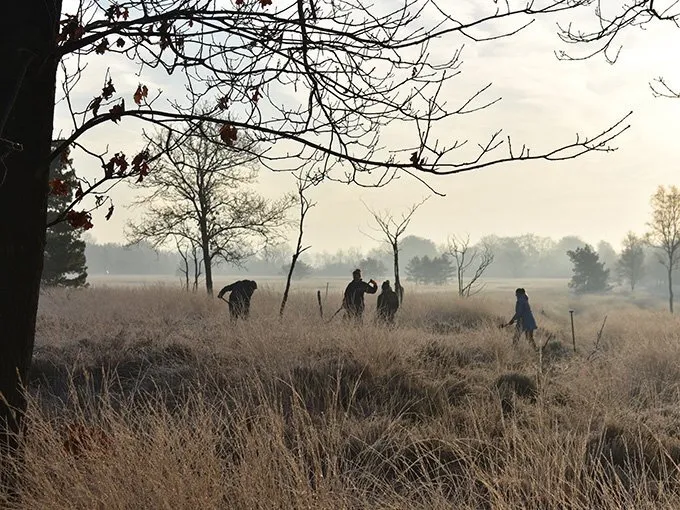Archaeologists Discover Roman Army Camp in the Netherlands—15 Miles Beyond the Empire’s Northern Border
Researchers think the camp was built during the second century C.E. Stretching across 22 acres, it was identified using a computer model developed by an archaeology student

About 2,000 years ago, the powerful Roman Empire established a boundary at the northern edge of its territory in continental Europe: the Lower German Limes, which stretched across the Rhine River in present-day Germany and the Netherlands.
But the Romans’ movements weren’t limited by their border. About 15 miles north of the Limes, researchers have identified the remains of a 22-acre Roman military camp in a forested area near the village of Hoog Buurlo. The camp features a ditch, a nearly ten-foot-wide defensive wall and several entrances, according to a statement from Utrecht University.
“The fact that it was discovered north of the Lower Germanic Limes, beyond the border of the empire, tells us that the Romans did not perceive the Limes as the end of their Empire,” Saskia Stevens, a historian at Utrecht University, tells Live Science’s Laura Geggel in an email.
/https://tf-cmsv2-smithsonianmag-media.s3.amazonaws.com/filer_public/87/23/8723d112-dd0e-4b84-b330-cd93c53bdcc8/ojrpsphfegvhytgzhyta6n-1200-80jpg.jpeg)
Stevens is the principal investigator for the research project “Constructing the Limes,” a collaboration between Dutch scholars who aim to learn more about how the Lower German Limes functioned. Per the statement, the recently discovered campsite was likely a “temporary marching camp,” where Roman soldiers stayed for only a few days or weeks during long movements. It may have served as a pit stop on the route to a nearby camp at Ermelo-Leuvenum, which is about a day’s walk away.
The discovery began with Saxion University archaeology student Jens Goeree, who “developed a computer model” to predict locations of ancient Roman military camps in a nature reserve called the Veluwe, Stevens tells McClatchy’s Aspen Pflughoeft via email. The model used data from elevation maps and lidar.
Need to know: How does lidar work?
- Lidar is a remote-sensing technology that emits laser pulses and measures how long they take to bounce back.
- By taking lidar scans from an airplane, scientists can generate 3D maps of the landscape below.
“He reconstructed possible routes of the Roman army across the Veluwe area, calculating the number of kilometers an army could travel per day,” Stevens explains to Live Science. Goeree’s program also looked for the Romans’ “typical playing card-shaped camps.”
Camps built by the Roman Empire’s military typically featured rectangular walls with rounded corners. Many examples have been found through Europe and even as far as Saudi Arabia, showcasing the empire’s vast reach.
Goeree’s model pinpointed a likely spot for a camp near Hoog Buurlo, and the researchers with Constructing the Limes excavated it in January. They unearthed just a few artifacts, including a piece of armor. Stevens isn’t surprised that they didn’t find more, as the camp would only have been used for a short time and “the soldiers would have traveled light,” she tells Live Science.
/https://tf-cmsv2-smithsonianmag-media.s3.amazonaws.com/filer_public/e8/5d/e85dbe39-fc0f-404a-a834-bb8583f1eb39/novaesium_bj_1904_tab_03.jpg)
“All you can really see above ground are some very subtle variations in height,” Stevens says in the statement. “The traces are mostly underground. The team was able to reveal them using advanced research methods,” such as lidar and aerial photography. The researchers think the camp was built in the second century C.E.
Over the years, archaeologists have found many forts, towers, cemeteries, canals and temporary military camps along the Limes. However, “only four such temporary Roman camps are known in the Netherlands,” Stevens says in the statement. Meanwhile, researchers have found dozens in Germany and hundreds in Britain.
“We are particularly interested in these kinds of camps because they provide valuable insights into Roman military presence and operations in frontier regions,” she adds. “They help us understand the routes taken by Roman troops and show how the Romans made extensive use of territories beyond the formal boundaries of their empire.”
Editors’ note, July 8, 2025: This article has been updated to clarify information about the Roman Empire’s northern border.
/https://tf-cmsv2-smithsonianmag-media.s3.amazonaws.com/accounts/headshot/Sonja_headshot.png)
